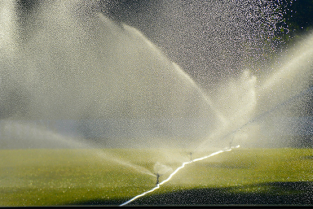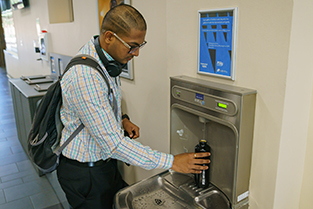Goal 6: Clean Water and Sanitation
Ensure availability and sustainable management of water and sanitation for all
Water scarcity affects more than 40 percent of people, an alarming figure that is projected to rise as temperatures do. Safe and affordable drinking water for all by 2030 requires we invest in adequate infrastructure, provide sanitation facilities, and encourage hygiene. Protecting and restoring water-related ecosystems is essential.
File downloads
Research and initiatives

Treating campus wastewater
The wastewater from toilets, sinks, and showers within ASU offices, residence halls, and laboratories enters the public sanitary sewerage system, where it flows to the treatment system at the 91st Avenue Wastewater Treatment Plant. This plant, which treats wastewater from the cities of Phoenix, Scottsdale, Glendale, Mesa, and Tempe, reclaims the treated wastewater for use as cooling water at Palo Verde Nuclear Generating station, irrigation water for agriculture, and aquifer recharge at the Tres Rios wetlands and the Agua Fria Linear Recharge Project. Additionally, the treatment plant produces fertilizer and biogas from the wastewater.

Water conservation off-campus
ASU supports water conservation off campus through direct action and policy engagement. ASU partnered with the City of Phoenix to install water-absorbing polymers (known as "hydrogel") below the root zone of turf at a city park. To date, this project has resulted in 20% water savings. ASU is also directly involved in developing water conservation policy, strategies, management and education at the local and state level.
The Arizona Water Blueprint—an interactive map of the state’s water resources and infrastructure created by the Kyl Center for Water Policy—facilitates dialogue around creating and deploying both state-level and local water visualization tools to support water conservation efforts statewide. ASU Project Cities also works with municipalities to develop water strategies.
ASU’s Landscape Architecture department collaborated with the City of Phoenix to create low-water designs for residential landscaping. The designs are paired with a transition guide and distributed by the City to residents at no charge. Replacing grass with native and drought-tolerant plants conserves water.
Additionally, the Arizona Water Innovation Initiative (AWII), a statewide project led by ASU’s engineering school and the Global Futures Laboratory. ASU works with industrial, municipal, agricultural, tribal, and international partners to rapidly accelerate and deploy new approaches and technology for water conservation, augmentation, desalination, efficiency, infrastructure, and reuse.

Free drinking water
ASU provides free drinking water at almost 1,000 free water-refill stations across all ASU campus locations. These stations provide students, staff and visitors a convenient way to refill your reusable water bottle so you can stay healthy and hydrated on campus. Find a water station on campus using this map.